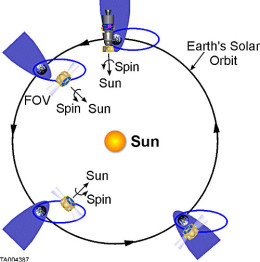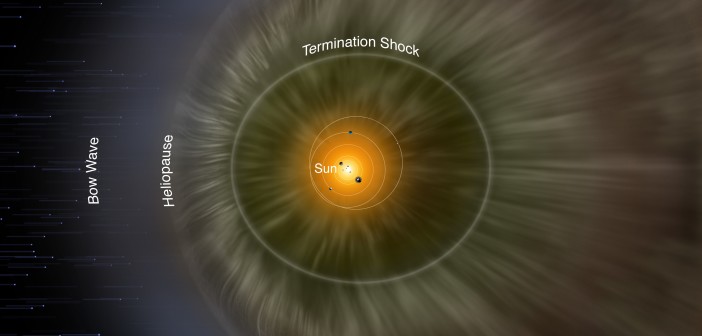The objective of the Interstellar Boundary Explorer, or IBEX, is to study the interaction between the solar wind and the interstellar medium (ISM) at the outer boundary of our solar system. In a special issue of the Astrophysical Journal Supplement Series, a set of 14 papers presents some of the most recent scientific results to come from the first six years of IBEX data.
The Heliosphere and IBEX
As the solar wind streams outward, it blows a bubble into the ISM known as the “heliosphere.” The outer boundary of the heliosphere, where the solar wind is no longer able to push the ISM out of the way, marks the edge of our solar system. We’d like to understand the composition and properties of both the heliosphere and the local interstellar environment, as well as the processes at work in the interstellar space around our Sun.How do we learn about these things? One approach is to send spacecraft to the edge of the heliosphere to make measurements, such as Voyagers 1 and 2. But these spacecraft are only able to measure properties at their specific locations — and since the heliosphere doesn’t appear to be symmetric, this is a major limitation. This is where IBEX comes in.

IBEX’s orbit around the Earth, at various stages in the Earth’s orbit around the Sun. IBEX makes its observations while outside of the Earth’s magnetosphere (purple shaded region). [SwRI/IBEX Team]
IBEX’s detections rely on two types of particles: 1) energetic neutral atoms, which are produced by charge exchange at the solar system boundary when the solar wind ions and the neutral ISM gas interact, and 2) various species of interstellar neutral atoms themselves that pass through the heliosphere and stream toward Earth. Detections of the latter type are the focus of the papers in this special issue of ApJS.
Latest Results
In the overview paper of this ApJS issue, PI David McComas (Southwest Research Institute) and coauthors outline the recent science results of IBEX. The major outcomes include:
- Resolution of the differences between IBEX’s and Ulysses’s measurements of helium atoms in the ISM
The space mission Ulysses, which gathered data while orbiting the Sun until 2009, measured a different temperature and direction for the interstellar flow of helium atoms than IBEX did. These two studies have now been reconciled and confirm that the local interstellar wind is significantly hotter than originally measured by Ulysses. - Determination of where the “pristine” ISM starts
Understanding the properties of the ISM outside of our solar system requires knowing how far out we need to look to observe ISM that hasn’t been mixed with atoms from our solar system. The studies presented here find that the distance to the “pristine” ISM is 1000 AU (that’s more than 30 times the distance to Neptune!). The temperature, speed, and direction of the ISM flow at that location are also presented. - Measurement of other interstellar neutral atoms
IBEX has gathered neutral hydrogen, oxygen, and neon particles, helping to identify the flows of these interstellar neutral atoms and the composition of the local region surrounding the heliosphere.
These results are the latest in a long stream of important scientific findings from IBEX — and as the mission has been extended through at least 2017, it seems likely that there will be many more!
Citation
D. J. McComas et al 2015 ApJS 220 22. doi:10.1088/0067-0049/220/2/22
The entire ApJS issue can be found here: http://iopscience.iop.org/0067-0049/220/2

